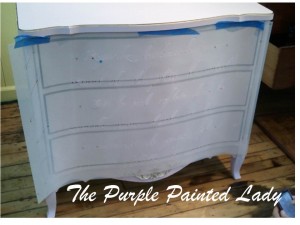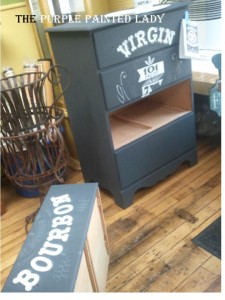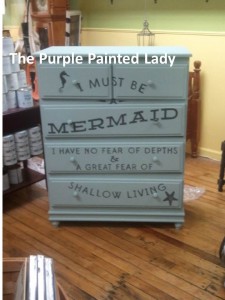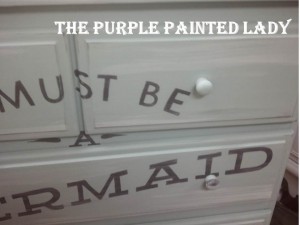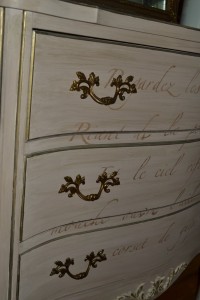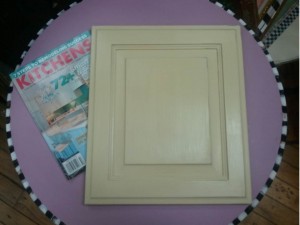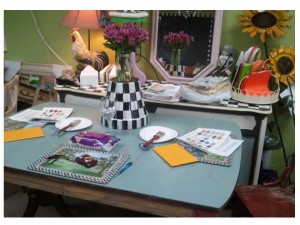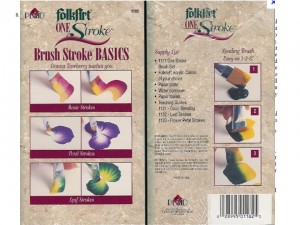Annie Sloan has done it again! Welcome to our newest Chalk Paint™ color that was inspired by the colors of the copper green mineral and semi-precious stone, malachite, and from the same family of stones as azurite and turquoise. In the 17th and 18th century it was used as a color made with verdigris but as it is a very fugitive color turning black with time so we are not aware of how it was used on woodwork in many houses. It is a classical color found in classical Italian furniture.
(Information and photo courtesy of Annie Sloan)
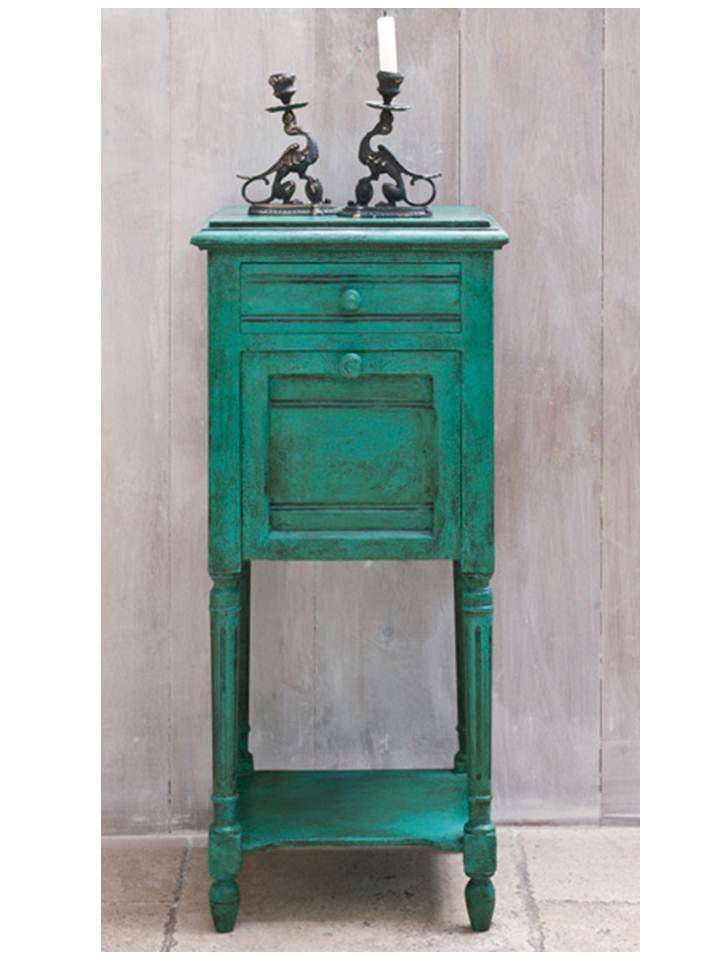
How To Make A “Wash” with Chalk Paint® & Stencil Tips
I have received a bunch of questions pertaining to the Bombay dresser that I posted on my Facebook page back in Feb. 2012 where I did a Coco wash over Antoinette. (see photo below)

You might remember this one since it had that pretty pale gold French poem stencil across the front! Ooh la la! Anyway- back to the wash “how to”…the type of paint you use for doing a wash is VERY important.
I am focusing on Chalk Paint® Decorative Paint by Annie Sloan here because that is my favorite paint and because of that….. it is what I sell in my shop and use when I want a velvety, silk-like finish. (Now don’t get me wrong- I still use Latex and love it depending on the end product I am going for – but try making a “wash” with latex…I would like to stress the sarcasm meant with that comment!)
This dresser was probably purchased at Sears back in the 1970’s. You know this style …because every little girl had a bedroom suite like it. And these pieces often had a laminate style top- which this one had. So, without any sanding or priming- I first painted the French Provincial dresser using Chalk Paint® in the color Antoinette. You can see what the surface looked like originally in the photo to the right. 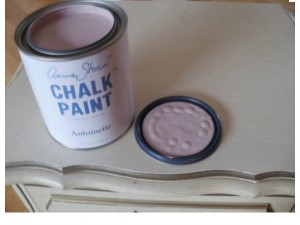
I love pink- but felt this piece needed a bit more. So, the stencil, “Spring Time in Paris” from Royal Design Studio is fantastic!
Springtime in Paris Stencil Set
And since this is a French Provincial style dresser, painted in Antoinette- it seemed appropriate to use a stencil written in French.
Now this is a big stencil. It is really meant for the wall or floor.  The dimensions are 51.75″ w x 21.5″ h. Made from reusable 10 mil mylar which is very substantial and can take long term use! Now, this stencil comes in 2 parts. Use both parts to complete the whole stencil. Based on the size of my dresser- I only used the first half- which means if you speak fluent French- you will read only partial sentences. (but shh! Since most of us won’t ever know that)
The dimensions are 51.75″ w x 21.5″ h. Made from reusable 10 mil mylar which is very substantial and can take long term use! Now, this stencil comes in 2 parts. Use both parts to complete the whole stencil. Based on the size of my dresser- I only used the first half- which means if you speak fluent French- you will read only partial sentences. (but shh! Since most of us won’t ever know that)
Using a little Modern Masters Metallic Gold- (Click HERE to purchase) I carefully blotted the lettering and stenciled the front. Just a small amount of Modern Masters Metallic Pale Gold will do it!  I use an inexpensive stencil brush that you can pick up at any craft store. Get paint on the brush and then blot some off…remember we are stenciling and do not want to have that much paint on our brush that it squirts under the stencil. Then with a vertical up and down motion- I blot the stencil. When it comes to stenciling- here are some tips to help you:
I use an inexpensive stencil brush that you can pick up at any craft store. Get paint on the brush and then blot some off…remember we are stenciling and do not want to have that much paint on our brush that it squirts under the stencil. Then with a vertical up and down motion- I blot the stencil. When it comes to stenciling- here are some tips to help you:
Stenciling Tip 1: Use a Professional Tool
Stenciling brushes are round with short, stiff bristles. Use it in a quick up-and-down movement to dab paint onto your stencil. This helps prevent paint getting under the edges. Never apply in a circular motion. A sponge or small roller works well too, but I prefer the brush.
Stenciling Tip 2: Work from The Outside
Start panting on the edges of the stencil, working into the center, rather than from the center outwards. Again this helps prevent paint getting under the edges as you’re less likely to accidentally bump the brush against an edge.
Stenciling Tip 3: Less is More
Don’t overload a brush with paint as it will bleed under the edge of the stencil. Load the brush lightly, so that the ends of the bristles are covered evenly- blot or wipe off any excess on a piece of paper or cloth.
Stenciling Tip 4: Think Thin
You will get better results by applying two thin coats rather than one thick one. Wait for the first to dry before applying the second. Do not remove your stencil until you are absolutely sure you are done.
Stenciling Tip 5: Get Sticky
Keep a stencil in place by taping it at the top and bottom with a piece of tape. Painter’s Tape works best as it’s very easy to remove and should not pull off any paint from the surface.
Stenciling Tip 6: Go Multi-Colored
To use more than one color in a stencil, use tape to mask off areas of the stencil you don’t want in a particular color so you do not forget and get carried away with the wrong color.
Stenciling Tip 7: Practice Makes Perfect
If you’re using various stencils together, first try it out on a piece of paper. It’s far easier to find out that something isn’t working at this stage versus having to try to correct it when you’re painting on your final surface.
Stenciling Tip 8: X-rated Stencils
Old x-rays are great for cutting stencils, so if you were unfortunate and have some – put them to good use.
Stenciling Tip 9: Wash Regularly
If you’re doing a repeat design, wash your stencil regularly in warm water to keep the edges free of paint. If there’s some paint on an edge, you won’t get a crisp edge to your painted stencil. As paper stencils don’t lend themselves to washing, acetate stencils are better for repeat designs. With a paper or card stencil, wipe off the excess paint, then leave the stencil for a bit so the paint on it dries, before using it again.
Stenciling Tip 10: Store stencils Flat
A stencil, obviously, needs to be flat to be usable. To stop it from buckling, put it between two pieces of cardboard and store it somewhere flat.
After finishing the stencil- I still felt the dresser needed something. So, at this point- I thought I would do a wash using the Coco.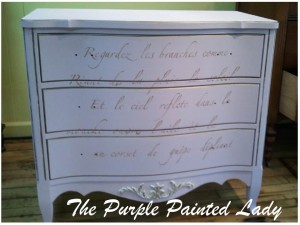
To make a “wash” – I first pour some Chalk Paint® into a plastic cup. A “wash” goes a long way in regards to coverage. For this dresser I used about a half cup of the Coco Chalk Paint™. I then took my Sharpie marker and made a line on my plastic cup noting how high the paint was in it. I did this in case I needed to make more.
Next…using a teaspoon add water to the paint-one teaspoon at a time (remember to measure and note the amount you add)….less is best since you can always add more water. The mixture of water and paint should begin to thin out. (Keep your paint:water ratio written down in case you need to make more!) The thinness or viscosity of the paint will be based on your preference. No recipe or rule here- but remember this is a “wash”– if you wanted to paint the piece- no need to add water. I added only a few teaspoons for my Antoinette painted dresser.
When I applied the Coco wash to the Antoinette dresser- I brushed it on with a cheap chip brush versus a heavy Purdy bristle brush. I laid the brush in its normal position…but used more of the tips versus the whole brush. Immediately next, I used a clean, lint free rag and wiped off the excess. That’s it- pretty simple, huh?
You do not want too much of the wash on the brush= enough to cover but not enough to cause dripping. I took the drawers out of the dresser and set them individually on their back as so to not have gravity work against me….like I show in this photo:
You can make a “wash” that goes on over a piece that has already been waxed or not waxed. I prefer doing the wash before I apply a coat of wax…but that is just my preference.
A wash makes for a real beautiful translucent effect! Let dry and then wax as normal. This is a great way to make a piece richer- which I think I did to this dresser.! OR…perhaps you want to try a bold color like Barcelona Orange, but are too chicken to “go for it”…I would suggest trying it in a wash first. It seems to be a more conservative approach and feels safer! And why buy glazes when you can do something similar but in any Chalk Paint™ by Annie Sloan!
HOW TO DO A WASH TECHNIQUE:
Try this “wash” effect with a color like Duck Egg over Old White….or French Linen over Graphite, Provence over Old Ochre OR just Old White “washed” over natural wood! There are no rules- but I hope the following helpful hints make this project idea more do-able for you! Please keep in mind the following….
1. Always note the water to paint ratio in case you do not make enough to finish the whole project. (can I stress this any more? But I learned my lesson once and ended up goofing up a piece over this simple rule! Learn from my mistake!)
2. Brush on the wash in strategic brush strokes–meaning keep your lines straight and clean
3. Be cautious not to drip on areas of the furniture you are not currently washing
4. Put a drop cloth down if doing this in your home…you will drip some on the floor.
5. Place your cup with the wash on a paper plate to keep work surface clean
6. Apply wash in small sections and wipe off – then move on to the next section. During the wiping off process- be careful to not have “rag blotch marks.” Start at the top and wipe off in clean, even pressured strokes all the way to the opposite side. Do not stop half way or go against the direction you want the streaks in. Never go in circles with the rag. If your rag becomes too saturated- get a new one.
7. I used a chip brush to apply- I like the streaky effect from the bristles.
8. Plan twice, “wash” once. Meaning- know your piece and your plan on how you are going to approach the project…top first, then sides.
9. If you are just trying a wash for the first time (or 2nd or 3rd) – it is best to do this on a piece that is smooth across. Meaning- not raised panels, or with carved details.
10. Always wipe off your wash in the direction of the brush strokes. Never do it in circles- it will look a mess.
11. Never place your rag down in the middle of a wash. Gently wipe from one direction to the other- otherwise you run the risk of leaving an imprint of the rag in the middle of your painted surface.
12. If you get a wash in a spot that you did not want…don’t fret. Let it dry- then gently sand it off using some 400 grit sandpaper.
And lastly- if you purchase the stencil I wrote about above – let me know your thoughts. I guarantee you will love it! And if you try this- please post a photo of your before and after on my FB page!
Here is another project I did a little wash on- for this project however, I was a bit more strategic in the location of where I applied the “wash.” I was going for the quintessential “Beach” feel – so a I used Old White to make my wash. I literally- dipped the tips of my brush into the paint that was on the paint can, and then dipped the bristles into a bit of water. I strategically brushed on the “wash” over the Duck Egg Blue dresser and then- using a cheesecloth, wiped some off. Always wipe in the direction you painted. (ps….the camera on my phone is quite mediocre – this looks much nicer in person!)Thanks for reading!

If interested in purchasing Annie Sloan products, please visit our website if interested in ordering Chalk Paint®. We have Chalk Paint® available for $34.95 per quart every day, we offer low/flat rate shipping and it always ships same day (as long as Pete, our UPS guy has not come already!)
In fact- there are many reasons we think buying through us is the best. Read THIS little post about what sets The Purple Painted Lady apart from the rest.
To visit our on-line store- click HERE.
Lastly, we share a lot more information to help you get the most functionality out of your Chalk Paint® on our Facebook page. Consider checking it out by clicking HERE. While there- kindly consider LIKING us.
Thanks again,
Tricia Migliore Kuntz ~The Purple Painted Lady ~
Design/Consulting, Kitchen Cabinet Refurbishing, Custom Painted Furniture, Chalk Paint® & Miss Mustard Seed Milk Paint Retailer & herRochester Blogger
PHONE: 585-750-6056
Come visit us:
At our MAIN STORE at 77 West Main Street in Macedon, NY 14502 OR
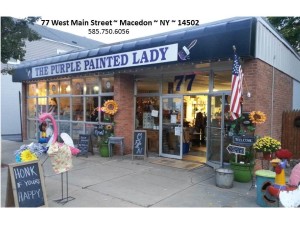
3200 West Ridge Road in Rochester, NY 14626 (The Shops On West Ridge) OR
Our Syracuse, NY location as of July 1, 2014 at 1 West Genesee Street, Baldwinsville, NY 13027
Click HERE for Store hours and information.

Scatter Mats Arriving in June! LOVE, Love, love these!
I am in LOVE with these floor coverings! Just a little preview below of some of the coolest scatter mats ….arriving at The Purple Painted Lady this month! I test everything I buy before selling. I purchased one of the 6 X 10 lettered mats a year ago. I have 2 BIG Rottweilers and they run & play on this mat- and it looks just as nice today as when I brought it home. I am very impressed! I also love that these come with their own non-slip bottom-so there is no need to buy a pad or non-slip base! Funk it up a little and get a fresh look! I will post their arrival on my Facebook page! So stay tuned.
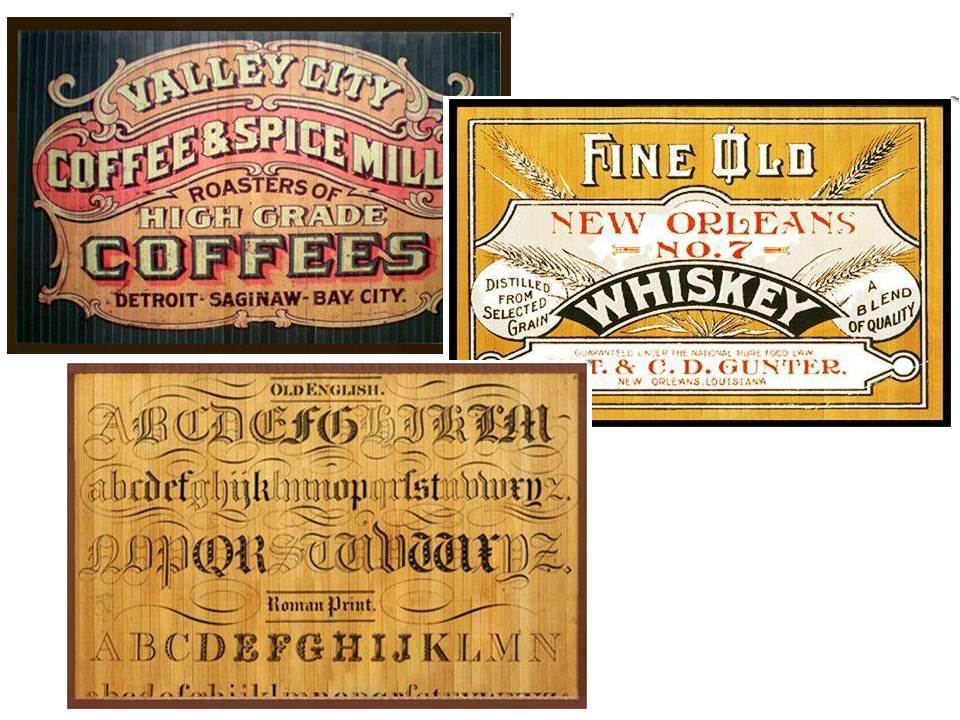
Two NEW Workshops at The Purple Painted Lady
I am so excited! We have added TWO NEW WORKSHOPS to our offerings! (and stay tuned- because we will be adding more fun & unique art classes this summer)
Kitchen Cabinet Painting Workshop
Ready to freshen up your kitchen but not interested in spending $1000’s to have it gutted or overhauled by a private contractor? Then this class is for you! Using Chalk Paint™ Decorative Paint by Annie Sloan we will teach you in this hands on workshop how to transform your cabinetry. You bring one cabinet door and by the time the workshop is over- you will have a finished piece and the skill to complete your whole kitchen.
This is a group workshop so as so to maintain a balance of my time among all students- the scope of your project needs to be within the duration of the class. Cabinet doors should be 16″ X 16″ or smaller.
CLASS SIZE: This class capacity would be for a maximum of 4 people and a minimum of 2- exceptions may be made based on my schedule- however, this would not set a precedent.
DURATION: 4 hours
If interested in inquiring – please email me at takuntzATrochester.rr.com (please use the @ sign where I have AT in that email address) and NOTE “Kitchen Cabinet Painting Workshop” in the subject.
COST: Pricing for the 4 hour workshop is $100 per person, $50.00 deposit at booking to hold your spot and the balance paid at the workshop. Pricing includes all materials and instruction to transform your cabinet door.
SINGLE SWIPE Painting Workshops! ~ STROKE OF GENIUS! (this would make a GREAT bridesmaid party or Girl’s Night Out!!!!! – BYOB of wine and munchies and make a party of it!)
You asked for it- and I am delivering it! ~(this would make a GREAT bridesmaid party or Girl’s Night Out!!!!! – BYOB of wine and munchies and make a party of it!) See the upside down large square pattern clay pot on the table??? Come and learn the basics, tips and tricks to get this effect and take a completed pot home. Pots will be primed and lay out completed – so you can focus on just learning & painting. Single swipe painting adds depth and interests to anything you paint! This can be done in any color combination- so please let me know prior so I can have the correct colors available! And this technique is perfect to expand on to create flowers, leaves, or to paint diamonds or stripes (set your imagination free and paint whatever you would like) This will be a 2 part workshop- about 2 hours for each class. …. $140 total. Interested? Contact me via takuntz@rochester.rr.com -note “Stroke of Genius” in subject. : )
CLASS SIZE: This class capacity would be for a maximum of 8 people and a minimum of 4- exceptions may be made based on my schedule- however, this would not set a precedent.
DURATION: This will be a two class workshop- 2 hours each in length.
COST: Pricing for the 4 hour workshop is $140 per person, $50.00 deposit at booking to hold your spot and the balance paid at the workshop. Pricing includes all materials and instruction to create your own painted planter pot.
If interested in inquiring – please email me at takuntzATrochester.rr.com (please use the @ sign where I have AT in that email address) and NOTE “ONE STROKE Brush” in the subject. More details will be shared when you write me.
Wax On…Wax Off. (Feeling like the Karate Kid!)
I receive questions about the proper process to apply Annie’s Clear Wax over Annie Sloan Chalk Paint™. I hope this analogy helps in your understanding of how thin to apply it.
When you wash your hair and put conditioner on it- what do you do next? 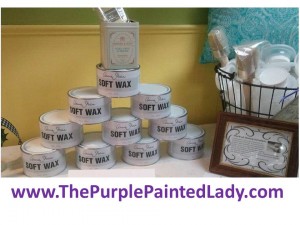
You wash it all off. And why is that?
Because your hair absorbs only what it needs. If you leave extra conditioner on your hair thinking it is going to make your hair better, what does it actually do?
It gives you a lousy hair day. This same concept applies to the wax. Annie Sloan Chalk Paint™ will absorb the wax that it needs. All excess beyond that- will just sit on your piece and make it feel tacky, gunny, or even sticky.
Now- some of you may be thinking- how do I know if I have too much wax?
A. When you apply the wax- if you can run your finger across it and see a mark or a ridge left behind- YOU HAVE TOO MUCH WAX on it! : )
B. Your project was a small side table or short shelf unit and you used a half tin of wax. guess what…YOU HAVE TOO MUCH WAX on it!
Keep in mind- even if you applied too much wax it is not horrible if you like the look of your piece! So, do not worry about it! And move on to your next project- be more aware or present when you apply the wax.
But again -you know you have too much wax or your wax is uneven when you see streaking in the wax. But all is not lost if this is your situation! And again- we want you to LOVE your piece and want to prevent you from using too much wax because it causes more work for you and wastes your product.
So… to remove excess dried wax:
1. Take a clean lint free rag (an old undershirt works great)
2. Grab your low odor mineral spirits (I have found that the “GREEN” mineral spirits do not work well for this application) and put your cloth on the mouth of the container and get 2 dabs of it on the rag. DO NOT SATURATE the rag with mineral- we do NOT want a wet rag dripping mineral spirits.
3. “Wipe” the excess wax off your piece. Do not scrub- and do not work in a small circular motion- you want to remove the wax evenly. So wipe from side to side.
Another option- in case someone has a smaller piece and does not want to bother with the mineral spirits- is to:
1. Let your wax totally dry
2. Sand lightly if surface seems uneven
3. Blow or wipe off dust
4. Re-paint with Annie Sloan Chalk Paint™ right over what you have done! No stripping or priming necessary!
But- let’s try to avoid this! I don’t want you to waste your time or product.
If you are local to me- I would invite you into my shop for a free quick demo on waxing! : )

